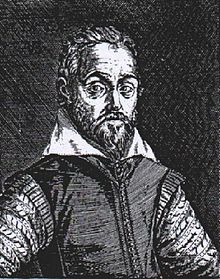
Joseph Duchesne or du Chesne (Quercetan, Latin Josephus Quercetanus) (c. 1544, Lectoure – 1609) was a French physician. A follower of Paracelsus, he is now remembered for important if transitional alchemical theories. He called sugar toxic, saying: “Under its whiteness, sugar hides a great blackness.”
Biography
Duchesne was born around 1544 in Lectoure, Armagnac and studied at Montpellier, and then at Basel, where he received a medical diploma in 1573. During the 1570s at Lyon, he married Anne Trie the granddaughter of Guillaume Budé, and became a Calvinist convert. He went into medical practice and became physician to Francis, Duke of Anjou.
He left Lyon in 1580 for Kassel in Hesse, and moved on to Geneva, where in 1584 he received citizenship. Duchesne was elected to the Council of Two Hundred in 1587, and undertook diplomatic missions to Bern, Basel, Schaffhausen and Zürich in the years 1589 to 1596. In 1594 he became a member of the Council of Sixty.
In 1598, following the Edict of Nantes, Duchesne returned to France and became physician-in-Ordinary attending Henry IV of France. In 1601 Nicolas Brûlart de Sillery gave him a mission as envoy to the Swiss cantons. In 1604 he went to the court of Maurice of Hesse-Cassel where he gave scientific demonstrations in a laboratory set up for him.
Works
- 1576 : Sclopetarius–On wounds made by muskets and similar weapons
- 1603 : De priscorum philosophorum verae medicinae material
- 1604 : Ad veritatem hermeticae medicinae ex Hippocratis veterumque decretis ac therapeusi
- 1606 : Tetras gravissimorum totius capitis affectuum, Marburg: Paulus Egenolphus, 1606.
- 1607 : Pharmacopea dogmaticorum
- (in Italian) La farmacopea overo antidotario riformato del signore Giuseppe Quercetano…, translated by Giacomo Ferrari. Venice, 1619
- (in French) La pharmacopée des dogmatiques, 2nd ed. with emendations. Rouen: Corneille Pitreson, 1639
- 1619 : Le Ricchezze della riformata Farmacopea del Giuseppe Quercetano. Nouamente di Favella Latina traportata in Italiana da Giacomo Ferrari - Venice: Guerigli, 1619.
- 1625 : Pharmacopeia restituta - Strassburg: Zetzner, 1625.
- 1625 : Diaeteticon polyhistoricum- Strassburg: Zetzner, 1625.
- 1625 : Tétrade des plus grièves maladies de tout le cerveau.
- 1639 : Traicté familier de l'exacte preparation spagirique des medicamens, Rouen: Corneille Pitreson
- 1648 : Quercetanus redivivus, hoc est, ars medica dogmatico-hermetica Vol.1-3 - Francofurti: Beyer, 1648.
Notes
| This article includes a list of references, related reading, or external links, but its sources remain unclear because it lacks inline citations. Please help improve this article by introducing more precise citations. (March 2014) (Learn how and when to remove this message) |
- Oddy, Derek J. (2016-02-17). The Rise of Obesity in Europe: A Twentieth Century Food History. ISBN 9781317017554.
- Colletet, Guillaume. Vies des poètes gascons. 1866, p. 147. There is a typo on the Galileo Project page.
- See "spagyric".
References
- Hirai, Hiro (2010). “The World-Spirit and Quintessence in the Chymical Philosophy of Joseph Du Chesne,” in Chymia: Science and Nature in Medieval and Early Modern Europe (1450–1750), ed. Miguel Lopez-Perez et al. Cambridge: Cambridge Scholars, pp. 247–261.
- Thomas, Joseph (1892), Universal pronouncing dictionary of biography and mythology (Aa, van der – Hyperius), vol. 1, Philadelphia: J.B. Lippincott, p. 797
- Westfall, Richard S. (1995), "Duchesne [Quercetanus], Joseph", Galileo Project page
External links
- Online Galleries, History of Science Collections, University of Oklahoma Libraries High resolution images of works by and/or portraits of Joseph Duchesne in .jpg and .tiff format.